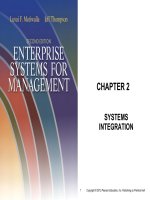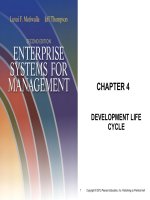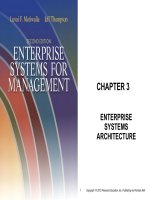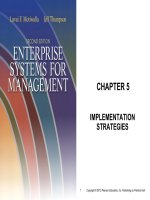Lesson Enterprise systems
Bạn đang xem bản rút gọn của tài liệu. Xem và tải ngay bản đầy đủ của tài liệu tại đây (1.57 MB, 48 trang )
Enterprise Systems
Study Questions
Q1 What is legacy system approach and
the problems of information silos?
Q2 What is enterprise system approach?
How to improve business processes
through Enterprise Systems?
Q3 What is ERP?
Q4 What is CRM?
Q5 What is SCM?
Q6 What are the challenges when
implementing new enterprise systems?
BUSINESS INFORMATION SYSTEMS
2
3
Q1 What is legacy system
approach and the problems of
information silos?
BUSINESS INFORMATION SYSTEMS
Information Systems in Enterprises
Source: textbook[2], page 280
BUSINESS INFORMATION SYSTEMS
4
Legacy System Approach
Source: textbook[2], page 290
BUSINESS INFORMATION SYSTEMS
5
Information Silos
►
An information silo exists when data is
isolated in separated information
systems
How Do Information Silos Arise?
►
Data isolated in islands of automation
►
Different department goals
►
Different personal and workgroup
needs
►
Duplicate data as organization grows
BUSINESS INFORMATION SYSTEMS
6
Problems Created by
Information Silos
Source: textbook[1], page 212
BUSINESS INFORMATION SYSTEMS
7
8
Q2 What is enterprise system
approach? How to improve
business processes through
Enterprise Systems?
BUSINESS INFORMATION SYSTEMS
Enterprise System Approach
Source: textbook[2], page 289
BUSINESS INFORMATION SYSTEMS
9
Supporting Business Processes
►
10
Internally focused systems
►
Support functional areas, business processes,
and decision making within an organization
►
New information (value) is added at every step
Source:
textbook[2],
page 290
BUSINESS INFORMATION SYSTEMS
Supporting Business Processes
►
Externally focused systems (interorganizational systems)
►
Coordinate business activities with customers, suppliers,
business partners, and others who operate outside the
organization
►
Streamline the flow of information between companies
Source: textbook[2],
page 291
BUSINESS INFORMATION SYSTEMS
11
Internally Focused Applications:
Value Chain
►
12
Flow of information through a set of business
activities
►
Core activities: functional areas that process inputs
and produce outputs
►
Support activities: enable core activities to take place
Source: textbook[2],
page 283
BUSINESS INFORMATION SYSTEMS
Value chain - Core Activities
►
Inbound logistics activities
►
►
Operations and manufacturing activities
►
►
Distribution of end products
Marketing and Sales activities
►
►
Order processing and/or manufacturing of end products
Outbound logistics activities
►
►
Receiving and stocking raw materials, parts, and
products
Presale marketing activities
Customer service activities
►
Post-sale activities
BUSINESS INFORMATION SYSTEMS
13
Value chain - Support Activities
►
Administrative activities
►
►
Infrastructure activities
►
►
Employee management
Technology development activities
►
►
Implement hardware and software needed
Human resource activities
►
►
Support of day-to-day operations (for all functional
areas)
Design and development of applications to support the
primary activities
Procurement activities
►
Purchasing of goods and services (inputs into the primary
activities)
BUSINESS INFORMATION SYSTEMS
14
Externally Focused
Applications—Value System
►
Coordination of multiple value chains
Source: textbook[2], page 285
BUSINESS INFORMATION SYSTEMS
15
Externally Focused
Applications—Value System
►
Information Flows in a Value System
►
Upstream information flow: information
received from another company
►
Downstream information flow: information
produced by a company and sent to another
organization
BUSINESS INFORMATION SYSTEMS
16
17
Q4 What is CRM?
BUSINESS INFORMATION SYSTEMS
Customer Relationship Management
(CRM)
►
Suite of applications, a database, and a
set of inherent processes.
►
Manage all interactions with customer
through four phases of customer life
cycle:
–
►
Marketing, customer acquisition,
relationship management, loss/churn.
Intended to support customer-centric
organization.
BUSINESS INFORMATION SYSTEMS
18
19
Customer Life Cycle
Source: textbook[1], page 218
BUSINESS INFORMATION SYSTEMS
CRM Applications
►
components exist for each stage of the
customer life cycle
Source: textbook[1], page 219
BUSINESS INFORMATION SYSTEMS
20
21
Q3 What is ERP?
BUSINESS INFORMATION SYSTEMS
Enterprise resource planning (ERP)
►
ERP: a suite of applications called
modules, a database, and a set of
inherent processes for consolidating
business operations into a single,
consistent, computing platform.
►
An ERP system is an information system
based on ERP technology
►
primary purpose: integration
BUSINESS INFORMATION SYSTEMS
22
Enterprise resource planning (ERP)
►
►
An ERP system integrate:
►
Supply chain (procurement, sales order processing,
inventory management, supplier management, and
related activities)
►
Manufacturing (scheduling, capacity planning, quality
control, bill of materials, and related activities)
►
CRM (sales prospecting, customer management,
marketing, customer support, call center support)
►
Human resources (payroll, time and attendance, HR
management, commission calculations, benefits
administration, and related activities)
►
Accounting (general ledger, accounts receivable,
accounts payable, cash management, fixed asset
accounting)
See more: ERP Guide
BUSINESS INFORMATION SYSTEMS
23
Pre-ERP Information System:
Bicycle Manufacturer
Source: textbook[1], page 221
BUSINESS INFORMATION SYSTEMS
24
25
ERP Information Systems
Source: textbook[1], page 222
BUSINESS INFORMATION SYSTEMS









